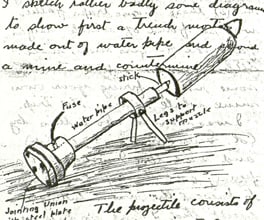Life in the trenches
As the northern hemisphere winter approached in 1914, the British and French forces had consolidated positions. Allied forces had prevented the Germans from reaching two key objectives: Paris and the port of Calais.
In general, the Germans had the higher ground on the Western Front, their trenches and dugouts were better protected and better prepared. German strategy became defensive early in the conflict as they realised they would have a hard enough time holding the ground they had won early in the war in Belgium and France.
The stalemate had created a corridor stretching up and down Europe the same distance as Melbourne to Sydney. A series of parallel trenches that were temporary homes for a million men.
Troops would serve time in the front or ‘firing line’ for four day spells and then return to support trenches and then to the villages behind the lines where they were billeted.
The front line was only lightly manned to ensure that soldiers could not be killed in a sudden bombardment or attack. To minimize damage from the concussion waves and shrapnel of exploding shells, the trenches were in zig-zags rather than straight lines. This also limited the sight-lines of attacking troops. Trenches were usually two metres deep and two metres wide to provide cover and transport access for supplies of ammunition and food.
The trench behind the front line was called a support trench and it was from this trench that troops could be called up to quickly defend an attack and reinforce the firing line.
Men were always at risk of being blown apart or buried alive by German high explosive shells or picked off by snipers:
During the afternoon a chap looked over where the trench was shallow, and said, ‘Look! I can see the German line!’ But that was the last thing he saw. He slumped down in the trench, shot through the brain.
- George Mitchell
Mitchell, G D 1937, Backs to the wall, Angus & Robertson, Sydney, N.S.W.
Rats and lice also lived with the soldiers and the conditions of the Western Front allowed them to thrive:
Great, sleek, corpse-fed rats ran in squads between our legs and over our feet as we stood. Their obscene squeaking could be heard at all times. Some men conceived an unmeasured hatred of these loathsome things, and were always trying to slaughter them. I wondered, as I stood, did they picture themselves as those scattered corpses- a prey to these. Imagination is decidedly not good for a soldier. It is one of the things Kipling forgot to tell us.
- George Mitchell
Mitchell, G D 1937, Backs to the wall, Angus & Robertson, Sydney, N.S.W.
Time spent on the Western Front was dangerous and the high arcs of German shelling meant death seemed to strike at random. Men grew used to seeing death. Stretcher-bearers witnessed the terrible impact of explosives on human flesh and were among the highest casualties themselves as they risked their own lives to rescue the wounded during and after engagements.
Captain George Mitchell - a Distinguished Conduct Medal winner -put survival this way: ‘The art of continued existence lay in being absent from a particular piece of scenery just when it came unstuck.’ Mitchell himself had a particular fear and distaste for the sucking mud of the Western Front. He would end up surviving the war and fighting in World War II.











